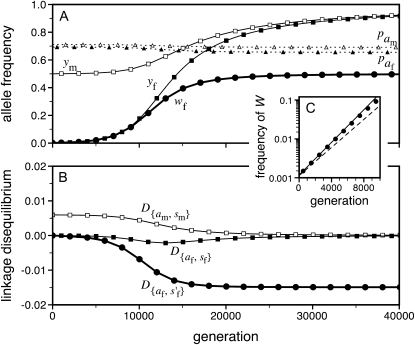Figure 1.—
A homologous transition from male to female heterogamety. (A) A feminizing allele segregating at a novel sex-determination locus on the ancestral sex chromosomes increases in frequency (solid circles) if it is more tightly linked to a sex-antagonistic locus than the ancestral master sex-determining gene ( and
and  in this simulation). The spread of the novel W allele is accompanied by an increase in the frequency of the ancestral masculinizing Y allele in both male and female gametes (open and solid squares, respectively) and slight changes in the allele frequencies at the sex-antagonistic locus (open and solid triangles/dashed lines). (B) The homologous heterogamety transition is driven by sex-antagonistic selection, which acts indirectly on the sex-determination loci through their nonrandom genetic association with sex-antagonistic alleles. (C) Initially, the W allele spreads at a nearly constant exponential rate and simulated frequencies (solid circles) fall along a straight line when plotted on a logarithmic scale. Analytical expressions for the invasion fitness of the W allele (dashed line, loose-linkage result; solid line, tight-linkage result) predict the slope of this line (i.e., the exponential rate of increase) during the initial phase of the simulations. Fitness values for the genotypes 00, 01, and 11 in females were given by
in this simulation). The spread of the novel W allele is accompanied by an increase in the frequency of the ancestral masculinizing Y allele in both male and female gametes (open and solid squares, respectively) and slight changes in the allele frequencies at the sex-antagonistic locus (open and solid triangles/dashed lines). (B) The homologous heterogamety transition is driven by sex-antagonistic selection, which acts indirectly on the sex-determination loci through their nonrandom genetic association with sex-antagonistic alleles. (C) Initially, the W allele spreads at a nearly constant exponential rate and simulated frequencies (solid circles) fall along a straight line when plotted on a logarithmic scale. Analytical expressions for the invasion fitness of the W allele (dashed line, loose-linkage result; solid line, tight-linkage result) predict the slope of this line (i.e., the exponential rate of increase) during the initial phase of the simulations. Fitness values for the genotypes 00, 01, and 11 in females were given by  ,
,  , and
, and  , respectively, with
, respectively, with  and
and  . Analogous expressions define fitness in males, with
. Analogous expressions define fitness in males, with  and
and  . Mutations between sex-antagonistic alleles occurred at rate
. Mutations between sex-antagonistic alleles occurred at rate  .
.

